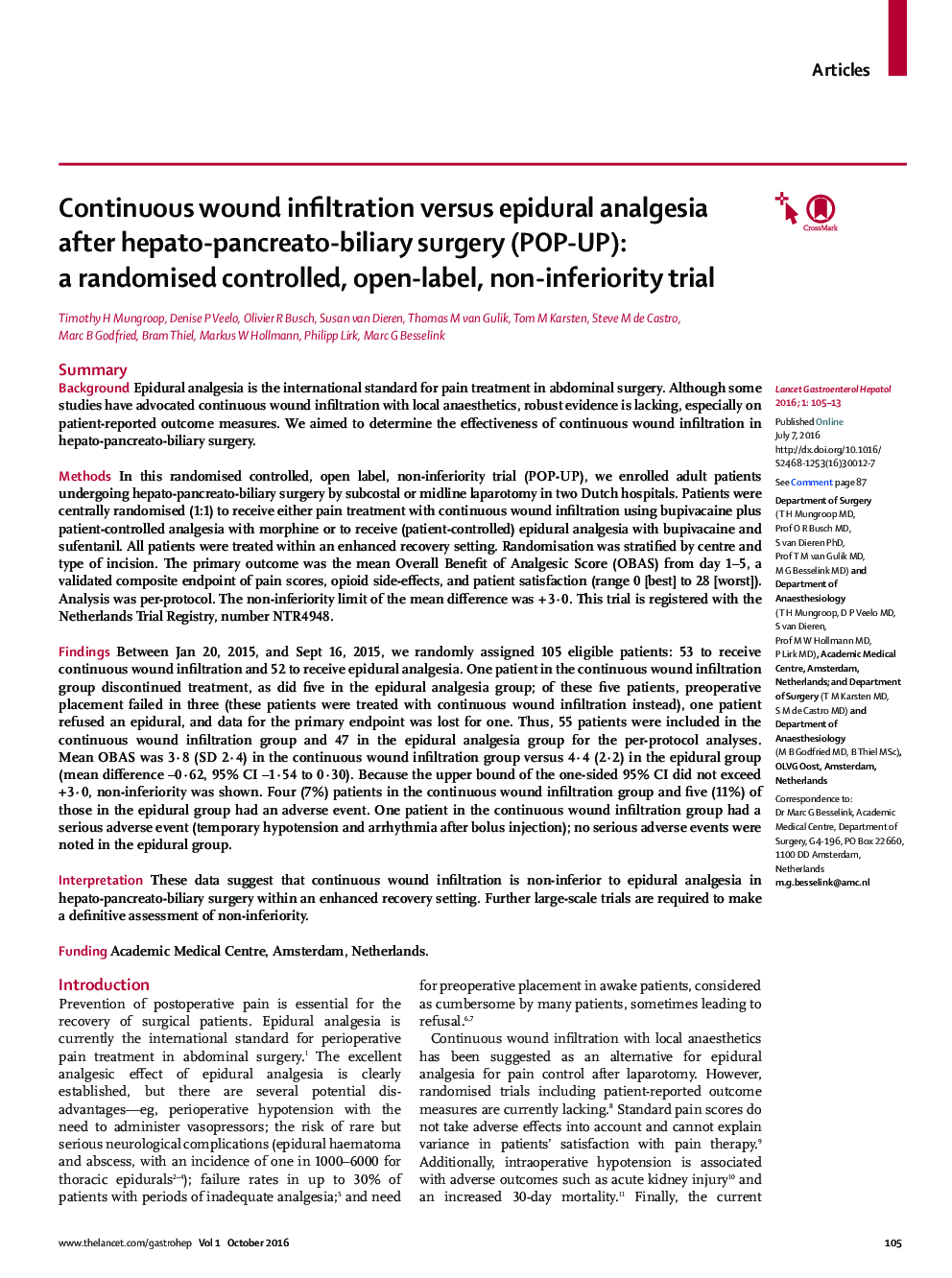| کد مقاله | کد نشریه | سال انتشار | مقاله انگلیسی | نسخه تمام متن |
|---|---|---|---|---|
| 3316252 | 1407513 | 2016 | 9 صفحه PDF | دانلود رایگان |
SummaryBackgroundEpidural analgesia is the international standard for pain treatment in abdominal surgery. Although some studies have advocated continuous wound infiltration with local anaesthetics, robust evidence is lacking, especially on patient-reported outcome measures. We aimed to determine the effectiveness of continuous wound infiltration in hepato-pancreato-biliary surgery.MethodsIn this randomised controlled, open label, non-inferiority trial (POP-UP), we enrolled adult patients undergoing hepato-pancreato-biliary surgery by subcostal or midline laparotomy in two Dutch hospitals. Patients were centrally randomised (1:1) to receive either pain treatment with continuous wound infiltration using bupivacaine plus patient-controlled analgesia with morphine or to receive (patient-controlled) epidural analgesia with bupivacaine and sufentanil. All patients were treated within an enhanced recovery setting. Randomisation was stratified by centre and type of incision. The primary outcome was the mean Overall Benefit of Analgesic Score (OBAS) from day 1–5, a validated composite endpoint of pain scores, opioid side-effects, and patient satisfaction (range 0 [best] to 28 [worst]). Analysis was per-protocol. The non-inferiority limit of the mean difference was + 3·0. This trial is registered with the Netherlands Trial Registry, number NTR4948.FindingsBetween Jan 20, 2015, and Sept 16, 2015, we randomly assigned 105 eligible patients: 53 to receive continuous wound infiltration and 52 to receive epidural analgesia. One patient in the continuous wound infiltration group discontinued treatment, as did five in the epidural analgesia group; of these five patients, preoperative placement failed in three (these patients were treated with continuous wound infiltration instead), one patient refused an epidural, and data for the primary endpoint was lost for one. Thus, 55 patients were included in the continuous wound infiltration group and 47 in the epidural analgesia group for the per-protocol analyses. Mean OBAS was 3·8 (SD 2·4) in the continuous wound infiltration group versus 4·4 (2·2) in the epidural group (mean difference −0·62, 95% CI −1·54 to 0·30). Because the upper bound of the one-sided 95% CI did not exceed +3·0, non-inferiority was shown. Four (7%) patients in the continuous wound infiltration group and five (11%) of those in the epidural group had an adverse event. One patient in the continuous wound infiltration group had a serious adverse event (temporary hypotension and arrhythmia after bolus injection); no serious adverse events were noted in the epidural group.InterpretationThese data suggest that continuous wound infiltration is non-inferior to epidural analgesia in hepato-pancreato-biliary surgery within an enhanced recovery setting. Further large-scale trials are required to make a definitive assessment of non-inferiority.FundingAcademic Medical Centre, Amsterdam, Netherlands.
Journal: The Lancet Gastroenterology & Hepatology - Volume 1, Issue 2, October 2016, Pages 105–113
